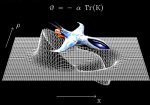Is that what is happening though? If I am moving at 30km/s in supercruise and another player is moving at 100c are we in different sized playing areas whilst simultaneously in the same playing area?
- - - - - Additional Content Posted / Auto Merge - - - - -
Yes. I'd love to know how Frontier have actually achieved this one though!

It's pretty basic, my dear Watson.
Ships, or at least their position are represented by a set of variables [X,Y,Z] which represent their position in space. You can change the X value from 100 to say "100 Ls" with a single assignment operation. The ship will be basically 'teleported' to that new location.
The same happens with animation.
Ships don't really 'fly' at all. They are teleported between the increments of the variable, however, the changes need to be synchronized with the video animation to achieve fluid motion.
If you know that the ship will move 60km in 1 second, then you just divide the distance by your current fps (let's assume 60), so you divide 60km by 60fps, and move the ship at 1km per frame.
So, computers (or at least games) don't have the lightspeed limit. The only limiting factor is the speed with which electrical current travels through the chips. But for game/simulation logic that's usually irrelevant, unless you're working with LHC.
TLDR; you can teleport anywhere instantly using a simple operation.

